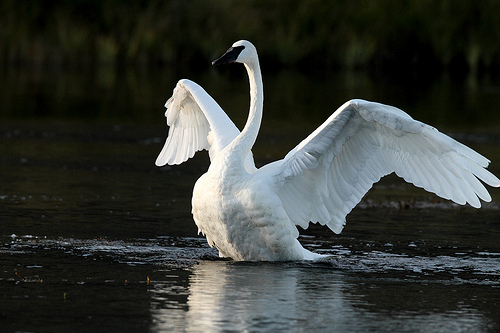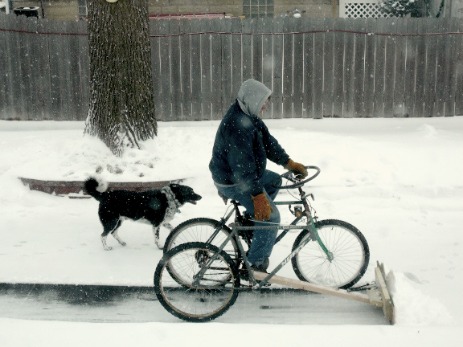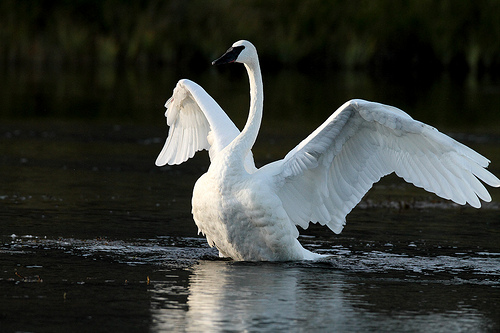 Honker flew the coop and dodged a bullet.Photo: Alan VernonThis piece was written by Bruce Dorminey.
Honker flew the coop and dodged a bullet.Photo: Alan VernonThis piece was written by Bruce Dorminey.
At first glance, Crescent Lake, a shallow body abutting a cornfield in upper Snohomish County, Wash., would appear to be perfectly pristine. Mallard and pintail ducks skirt the edges of its banks on waters that — in this contaminated age at least — would seem to be as untouched as anyone could hope.
But as wildlife biologist Martha Jordan explained on a recent rain-sodden Northwest afternoon, the lake has become lethal to the celebrated trumpeter swan, the world’s largest waterfowl.
The trumpeter swan, or cygnus buccinators, winters along hundreds of miles of the Pacific Northwest. For more than a decade, however, large numbers of these birds have died from lead shot — not shot fired at them, but historical deposits of shot fired from shotguns of days gone by.
The lead can be picked up as grit or consumed by accident along with the swan’s food source. Because birds don’t have teeth, they use the grit to help break up or grind their food in their gizzards.
“Waterfowl think lead shot is grit,” said Jordan, the Washington Working Group chair for the Trumpeter Swan Society. “They eat it for digestion, then it gets into their bloodstreams. It only takes three pellets to kill a trumpeter swan.” A single shotgun shell can contain more than 250 lead pellets.
Wildlife biologists began to find dead swans in lakes and fields in 2001. To date, at least 1,600 swans have died, mainly in northwestern Washington and southwestern British Columbia.
Before the 1800s, trumpeter swans could be spotted in every continental U.S. state and across sub-Arctic Canada. Before the turn of the last century, the Hudson’s Bay Company shipped many trumpeter swan skins to Europe. Its quills made the best pens and also were in demand for hats, clothing, and powder-puffs. By the late 1800s, most thought the species was extinct. It wasn’t until 1919 that two nests were found in Yellowstone National Park, although some others apparently survived in more remote portions of Alaska and Canada. By 1935, it’s estimated that there were fewer than 100 trumpeter swans left.
Today, with trumpeter swans protected from hunting, it’s estimated that the population represents less than a third of their pre-colonial numbers. Some 26,000 trumpeter swans breed and nest in Alaska and winter along the Pacific coast from the end of October through mid-March.
Their range runs from west of the Cascade mountain range to as far south as Oregon’s Willamette Valley. Washington’s Whatcom and Skagit counties have the largest wintering population in the contiguous U.S.
Before European settlement in this area, the swan’s natural winter habitat was found in Puget Sound’s intertidal estuaries and marshlands, where it mostly fed on aquatic vegetation.
But the wintering swans disappeared after settlers erected dikes and drained the marshlands. Swans began a comeback in the early 1960s, Jordan said, after discovering that agriculture here also made a good winter food source.
A few miles away, Jordan pulls over to watch a couple of hundred trumpeter swans feasting on a field of harvested corn. To replenish their fat from the breeding season, she said, they come here to eat waste corn from the harvest. Trouble is, there’s also lead in these fields.
The fields here can be just as lethal as lakes, even though their lead concentrations are lower.
Lead shot for use in hunting waterfowl has been illegal in the United States since 1991. And about half of the states have some sort of restrictions on lead shot, while others are considering them.
In a high-profile effort to assist the recovering California condor population, which scavenges on carcasses often pockmarked by lead, the California legislature passed a bill in 2008 mandating that hunters in condor habitats use non-lead-only ammunition. However, a 2010 bill to ban lead shot from California’s system of wildlife management areas failed to pass in the state’s senate.
While the Environmental Protection Agency has been petitioned to ban all lead in ammunition, it is still legal to use lead shot to hunt pheasants and shoot doves, and for skeet and trap target ranges. So lead shot is still being deposited in various habitats (as are lead sinkers from fishing gear).
Once lead is scattered to the wind, Jordan noted, it stays where it lies. It doesn’t “magically disappear.”
The first indication of lead poisoning in birds is lethargy. But by the time the swans start showing lead’s effects, it’s too late to save them, said University of Washington wildlife biologist Mike Smith. Their life span after ingestion is only about three weeks.
Of nearly 2,200 swan carcasses collected from 2000-2009, 71 percent of their deaths were lead-related.
Doug Zimmer, a spokesman with the U.S. Fish and Wildlife Service, explained that in the last decade, researchers radio-collared and tracked more than 500 swans to figure out where they were feeding and roosting and ingesting the lead shot. (A PDF of their report is here.)
Eventually, the collared birds led the researchers to Judson Lake. After taking samples of the lake bottom, they discovered lead in its sediment.
The 100-acre lake, which spans the U.S.-Canada border, has the heaviest lead concentration of any known lake and is thought to be the source of 70 percent of swan poisoning over the last decade. Over the years, its polluting lead shot has sifted down into the shallow lake’s soft mud bottom — which is unfortunately also within easy reach of the long-necked swans.
Thus, the researchers’ first priority became keeping the birds off the lake altogether.
“Keeping staff full time to haze the swans off Judson Lake is not a long-term solution,” said U.S. Fish and Wildlife Service environmental contaminant specialist Cindy Schexnider. “So, we’re monitoring the swans with a webcam.”
Smith says that for three years, the researchers succeeded in keeping the birds completely off Judson Lake.
“Last year,” Smith said, “we built a 35-acre exclusion area covered with bamboo poles and mylar tape and allowed the swans to use areas of the lake with very low lead densities.”
Largely as a result, mortalities of the Pacific coast trumpeter swan population from lead shot ingestion have declined by 82 percent since 2008.
Even so, Smith says in western Washington, swan lead poisoning is down about 71 percent from its highs earlier in the decade.
Although such statistics are impressively positive, Jordan, for one, hasn’t declared victory. “We’re not winning the war with lead poisoning,” Jordan said, “we’re not even coming close.”
At Judson Lake, where some 800 swans spend the winter each year, one hundred have died in the last two years.
A permanent fix at Judson Lake might involve hundreds of thousands of dollars worth of dredging to sift out the lead. But in these tough economic times, Jordan says there’s no money for such solutions. So, for now, the best that can be done is to simply keep the swans off the lake.
Meanwhile, researchers expect that Judson Lake likely represents only the tip of a broader lead pollution iceberg.
“As the swan population increases and expands further south,” Zimmer said, “the swans will tell us with their dead and dying bodies where there is more lead.”
This article was syndicated with permission from Miller-McCune, an online and print magazine that focuses on practical options for solving serious problems, particularly if the options are backed by quality research and evidence.



